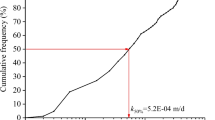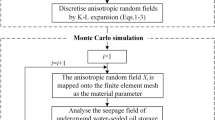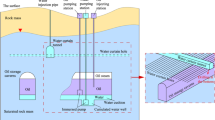Abstract
The key to preventing the seepage of hydrocarbons from underground water-sealed oil storage facilities is to maintain a certain thickness of groundwater on the top of the caverns so that the groundwater pressure can maintain their tightness. However, the presence of fractures in the rockmass that surrounds the caverns complicates the calculation of the seepage field in the oil storage area. Conventional two-dimensional or equivalent three-dimensional seepage models cannot accurately reflect the impact of the fractures on the seepage field. Therefore, in this study, a dual-porosity medium modeling approach was used to develop an unsteady-state seepage model using the three-dimensional discrete element software 3DEC. The model was developed to assess the effect of grouting on the rock mass that surrounds oil storage caverns that took into account the possible presence of non-persistent fractures. Thus, the simulation of the three-dimensional seepage field of large-scale water-sealed oil storage caverns was realized. The three-dimensional seepage field evolution law and seepage control effect under different working conditions during the construction and storage phases were studied. The results can provide a particular reference for the construction and operation of large-scale underground water-sealed oil storage caverns.











Similar content being viewed by others
References
Åberg B (1977) Prevention of gas leakage from unlined reservoirs in rock. In: Proceedings of the first international symposium: storage in excavated rock caverns. Rockstore, Stockholm, pp 399–413
Cheng Z, Wang X, Ren B, Lv P, Zhu X (2018) Simulation of complex seepage field of a gravity dam foundation using a CFD-Based approach. J Hydraul Eng 144(3):5018001
Dai Y, Zhou Z (2015) Steady seepage simulation of underground oil storage caverns based on Signorini type variational inequality formulation. Geosci J 19(2):341–355
Goodall DC, Berg B, Brekke TL (1988) Fundamentals of gas containment in unlined rock caverns. Rock Mech Rock Eng 21(4):235–258
Hu C, Chen H, Chen G, Liu J (2019) Detection of low-efficiency zones of water curtain system for underground LPG storage by a discrete fracture network model. Environ Earth Sci 78(1):1–10
Itasca Consulting Group, Inc. (2016) 3DEC 3-dimensional distinct element code version 5.2, Minneapolis: ICG.
Li S, Ping Y, Wang Z, Xue Y, Li S, Wang G, Zhao J (2012) Assessments of containment and stability of underground crude oil storage caverns based on fluid–solid coupling theory for discrete medium. Chin J Rock Mech Eng 11(31):2161–2170
Li Y, Chen Y, Zhang G, Liu Y, Zhou C (2017) A numerical procedure for modeling the seepage field of water-sealed underground oil and gas storage caverns. Tunn Undergr Sp Tech 66(2017):56–63
Li W, Wang Z, Qiao L, Liu H, Yang J (2020) Determination of the optimal spacing of water curtain boreholes for underground oil storage from the perspective of percolation theory. Tunn Undergr Sp Tech. 97:103246
Li J, Wang Y, Tan Z, Du W, Liu Z (2021) Study on water inflow variation law of No.1 shaft auxiliary shaft in highligongshan based on dual medium model. Symmetry 13(6):930
Lin F, Ren F, Luan H, Ma G, Chen S (2016) Effectiveness analysis of water-sealing for underground LPG storage. Tunn Undergr Sp Tech 51:270–290
Liu Q, Sun L (2019) Simulation of coupled hydro-mechanical interactions during grouting process in fractured media based on the combined finite-discrete element method. Tunn Undergr Sp Tech 84:472–486
Liu H, Haukwa CB, Ahlers CF, Bodvarsson GS, Flint AL, Guertal WB (2003) Modeling flow and transport in unsaturated fractured rock: an evaluation of the continuum approach. J Contam Hydrol 62–63:173–188
Qiu D, Fu K, Xue Y, Li Z, Ning Z, Zhou B, Tao Y (2021) Seepage field prediction of underground water-sealed oil storage cavern based on long short-term memory model. Environ Earth Sci 80(17):1–15
Usmani A, Kannan G, Nanda A, Jain SK (2015) Seepage behavior and grouting effects for large rock caverns. Int J Geomech 15(3):6014023
Wang Z, Zhang Z, Li S, Bi L, Fang S, Zhong K (2016) Assessment of inter-cavern containment property for underground oil storage caverns using discrete fracture networks. J Shandong Univ (eng Sci) 46(2):94–100
Xu ZH, Bu ZH, Gao B, Pan PD, Lin PD, Nie LC (2021) Sensitivity analysis and prediction method for water inflow of underground oil storage caverns in fractured porous media. Int J Geomech 21(2):1–14
Zhang B, Shi L, Yu X, Qi S (2019) Assessing the water-sealed safety of an operating underground crude oil storage adjacent to a new similar cavern—a case study in China. Eng Geol 249(2019):257–272
Zhang Q, Liu Q, He G (2020a) Reexamining the necessity of adding water curtain borehole with improved understanding of water sealing criterion. Rock Mech Rock Eng 53(10):4623–4638
Zhang X, Chen H, Yao C, Yang J, Jiang S, Jiang Q, Zhou C (2020b) Seepage characteristics of triaxial compression-induced fractured rocks under varying confining pressures. Int J Geomech 20(9):1–11
Zhao Y, Liu Q, Zhang C, Liao J, Lin H, Wang Y (2021) Coupled seepage-damage effect in fractured rock masses: model development and a case study. Int J Rock Mech Min 144:1–22
Acknowledgements
This study was jointly supported by the National Natural Science Foundation of China (No. 51778070), Natural Science Foundation of Hunan Province (No. 2019JJ50642), Scientific Research Project of Hunan Provincial Department of Education (18C0191) and the Fund of National-local Joint Engineering Laboratory for Road Engineering and Disaster Prevention and Mitigation Technology in Mountainous Areas.
Author information
Authors and Affiliations
Corresponding author
Ethics declarations
Conflict of interest
The authors declare that they have no conflict of interest to this work.
Additional information
Publisher's Note
Springer Nature remains neutral with regard to jurisdictional claims in published maps and institutional affiliations.
Rights and permissions
About this article
Cite this article
Tang, D., Yin, T., Xiao, Z. et al. Development of a modeling tool to assess seepage management options for large-scale water-sealed oil storage caverns. Environ Earth Sci 80, 652 (2021). https://doi.org/10.1007/s12665-021-09930-x
Received:
Accepted:
Published:
DOI: https://doi.org/10.1007/s12665-021-09930-x




